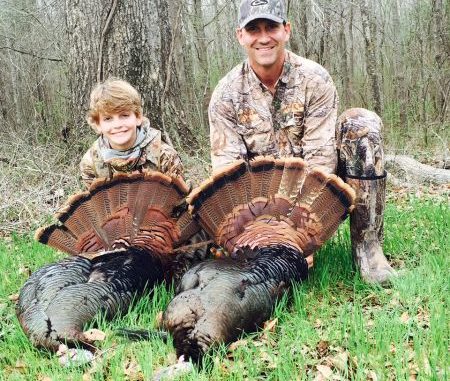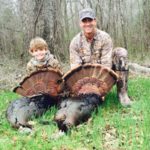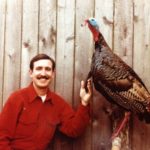
Turkey hunting then and now
The 2015 spring turkey season was, as of this writing, a total bust for me, as I have been neck-deep in the moving process to a new house that the wife and I have been building and dealing with for some months now.
One of the good things about moving involves cleaning out accumulated clutter and finding things you forgot about and not seen in a while. While cleaning out a bookcase, I ran across my 1980 daily journal that chronicled, among other things, the daily goings-on during my very first turkey season.
You see, 35 years ago turkey hunting was not the high-profile, main-stream activity that it is today.
I had already been enjoying deer hunting for 10 years, having started while studying engineering at Mississippi State University in 1970, but the bug to pursue turkeys had just not yet taken hold.
No. 1, turkey populations were still somewhat scattered and sparse in most locales. Back in the early days, I had been deer hunting off and on on public land — primarily at the Copiah County Game Management Area, otherwise known as “Henneberry” to the locals.
During the several years that I deer hunted there, previous to 1980, the management area was totally closed to turkey hunting. There was a good and growing population of birds during the 1970s, so as we approached the spring of 1980, biologists decided to open up Henneberry for its first spring turkey season.
Being a neophyte to the sport, I bought a cedar box call and an instructional cassette tape of how to call by the renowned Alabama turkey hunter Ben Rogers Lee.
We didn’t have all the fancy gear and clothing that is so common today. At that time, the well-dressed turkey hunter wore U.S. Army surplus fatigues in woodland camo pattern, and virtually no one used decoys or popup blinds unless you made them yourself from scratch. Looking back today, I now recognize how crude the available trappings were for a turkey hunter.
My initial attempt at turkey hunting was really remarkable, given the state of the art and the state of my knowledge at the time.
According to my journal, the opening day for turkey season was March 22, 1980. My handwritten entries for the opening weekend read: “22/Saturday — Turkey Season opens — Hunted @ Copiah Co. WMA — clear and cold — 30-degree low – 70-degree high — Heard at least seven or eight gobblers. Had 11 turkeys in gun range — Two gobblers sparred 75 yards away — unbelievable! Saw eight deer — Was in woods @ 5:40 (gray light). Too light — Should leave at least 30 to 45 minutes earlier!”
Now, bear in mind that back in the day, “blue laws” were still in place and many businesses and public places, such as state management areas, were closed on Sunday.
So, in spite of the wondrous things I had seen and heard on opening morning at Henneberry, I had to find somewhere else to hunt the next morning.
I chose a piece of International Paper land with which I was familiar and that was also in Copiah County. My journal notes the details.
“23/Sunday — Cloudy day — cool — Hunted on IP land powerline ROW — Heard no gobblers early — Set up stationary and called — called in first gobbler, but got antsy and left position too quick and spooked him — Moved and set up against a big tree trunk and called off and on — Called in two gobblers to eight steps and did a quick draw and killed one — too close — lucky shot with 16-gauge mod. choke No.#4 magnum.”
Here I was, green as a gourd at turkey hunting, with a nice, fat gobbler in hand on the second morning, having had numerous other opportunities to connect during the opening weekend.
I went on to fill my three-gobbler limit for the season over the next two or three weeks, and I was hopelessly hooked from that point on.
Now, let’s fast forward to this current season and, as a contrast, let’s look at what happened to a friend of mine during the opening days of his very first turkey season.
My friend Trey owns a piece of hunting property in West Central Mississippi he has primarily deer hunted on prior to this season.
Trey has seen numerous turkeys on his property by way of trail camera photos or sightings during deer season. As a result, he decided that it was high time to try turkey hunting.
Right before the season opened, he set up a pop-up blind on the edge of a green plot that was bordered by a shallow creek on the opposite side of the field from his blind.
Trey has a 12-year-old son named Kinsman who loves to hunt, but his school schedule was not going to allow him to hunt during the week with his dad unless it was a late-afternoon hunt. After Trey tried out the blind and bagged a longbeard, Kinsman was about to bust to go turkey hunting with his Dad.
So, on March 19 Trey grabbed all of their turkey-hunting gear and raced to pick up his son right as school let out for the day. They then struck out straight for the hunting property.
Arriving at the already prepared and christened blind, they placed a hen decoy off to one side and slightly to the rear, but the decoy was plainly visible to any gobbler that came into the field.
They had been in the blind about 45 minutes when they spotted four gobblers inside the far wood line about 75 yards away. Trey yelped to them, with little response being shown by the gobblers.
They then heard a gobbler clucking and coming in from the decoy side of the blind. There was no opening in the blind on that particular side, so they were flying blind as Trey threw a couple of answering clucks at the approaching gobbler.
They sat tight, listening and looking as everything went completely quiet.
Suddenly they heard rustling noises in the opposite direction and turned to look just in time to see two long-beard gobblers running into the food plot with their necks stuck straight out.
Whispering back and forth, they quickly coordinated — you take left and I take right.
As the two gobblers came to a screeching halt, they raised their heads to survey the situation. Kinsman fired at his gobbler first, quickly followed by Trey.
The twin magnum loads of shot instantly anchored both long-beard toms in their tracks.
As has played out countless times in the turkey woods between fathers and sons or daughters, both hunters laughed, grinned from ear-to-ear, high-fived and hugged each other before running out to claim their prizes.
But there is a final anecdote to this story.
After triumphantly returning home and dressing the birds, they salted and carefully placed the legs and beards of all three turkeys on cardboard on the garage floor to dry. A couple of afternoons later they did another late-afternoon hunt after school hours.
Returning home after dark, Trey’s heart sank as they entered the garage and he saw that the door to the house was ajar. There were no gobbler legs to be seen and the floor was covered — like pick-up sticks — with loose, black strands of beard.
Their dog had gotten into the garage and, after chewing on the legs like dog chews, he hid them all over the house.
The fleshy chest appendages that held each beard together had been eaten, and all that was left was a pile of individual beard strands.
When I last spoke to Trey, what remained of only five of the total six legs had been found, and they had picked up all the loose beard strands in one big bundle.
Oh, well: The breasts were tasty, the photos are a treasure and boy have they got a whopper of a story to tell when anyone in the future asks about their huge inch-and-a-half diameter “super beard.”




